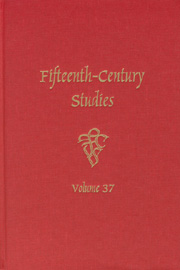Book contents
- Frontmatter
- Contents
- Essays
- Tradition and Innovation in 15th and 16th Century Popular Song Poetry: From Oswald von Wolkenstein to George Forster
- The Poet at the Mirror: René d'Anjou and Authorial Doubling in the Livre du Cœur d'Amour épris
- Modern Translator or Medieval Moralist?: William Caxton and Aesop
- A Battle of “Trechour Tung[s]”: Gaelic, Middle Scots, and the Question of Ethnicity in the Scottish Flyting
- Wheels and Wycliffites: The Role of Sacred Images in Capgrave's The Life of Saint Katherine
- Sympathy for the Devil: Gilles de Rais and His Modern Apologists
- Milieu, John Strecche, and the Gawain-Poet
- Thinking on Paper: Reference Tools, Tables, and Diagrams in Conrad Buitzruss's Compendium (Clm 671)
- Book Reviews
Thinking on Paper: Reference Tools, Tables, and Diagrams in Conrad Buitzruss's Compendium (Clm 671)
from Essays
Published online by Cambridge University Press: 05 February 2013
- Frontmatter
- Contents
- Essays
- Tradition and Innovation in 15th and 16th Century Popular Song Poetry: From Oswald von Wolkenstein to George Forster
- The Poet at the Mirror: René d'Anjou and Authorial Doubling in the Livre du Cœur d'Amour épris
- Modern Translator or Medieval Moralist?: William Caxton and Aesop
- A Battle of “Trechour Tung[s]”: Gaelic, Middle Scots, and the Question of Ethnicity in the Scottish Flyting
- Wheels and Wycliffites: The Role of Sacred Images in Capgrave's The Life of Saint Katherine
- Sympathy for the Devil: Gilles de Rais and His Modern Apologists
- Milieu, John Strecche, and the Gawain-Poet
- Thinking on Paper: Reference Tools, Tables, and Diagrams in Conrad Buitzruss's Compendium (Clm 671)
- Book Reviews
Summary
In 1422, fifteen-year-old Conrad Buitzruss began his studies at the University of Heidelberg and started to copy an assortment of Latin and German texts into what became an octavo-sized codex now known by the signature Clm 671. Over the next five years, the young compiler neatly transcribed texts on astrology, medicine, geomancy, ritual magic, medical remedies, the culinary arts, and other artes mechanicae into the codex's first ten gatherings — creating a striking array of visual elements in the compendium: a number of tables, charts, astronomical illustrations, volvelles, and other kinds of imagery as well as schematically arranged words and lists.
Buitzruss's interests come to be seen as broad-ranging in this early fifteenth-century corpus inasmuch as intellectual traditions are juxtaposed with popular ones. Such disparate fields as time-keeping and magic intermingle within its leaves. The miscellaneous character of the compendium is aptly shown in the collection's last gathering, where readers find trivial and didactic poetry drawn into close proximity with practical instructional material. Yet these diversified areas of knowledge emerge as more Buitzuss's inventive undertaking than an assemblage of unrelated materials. The anthologist's intimate familiarity with traditional scholarly practices becomes evident as well as the remarkable intensity of his engagement with both the texts and ideas that he committed to writing. In the pages that follow, I will describe and discuss the compiler's adept use of conventional scribal reference tools and consider what he meant to convey by including tabular displays of a traditional nature.
- Type
- Chapter
- Information
- Fifteenth-Century Studies 37 , pp. 201 - 224Publisher: Boydell & BrewerPrint publication year: 2012



